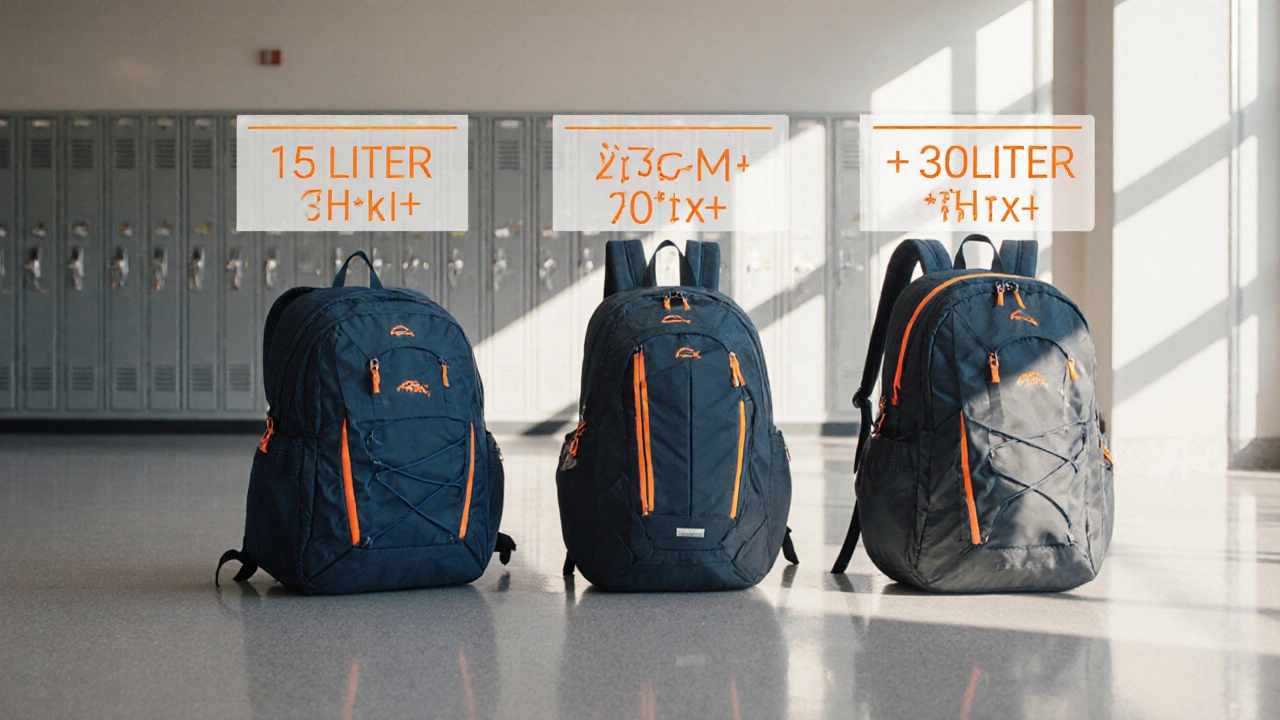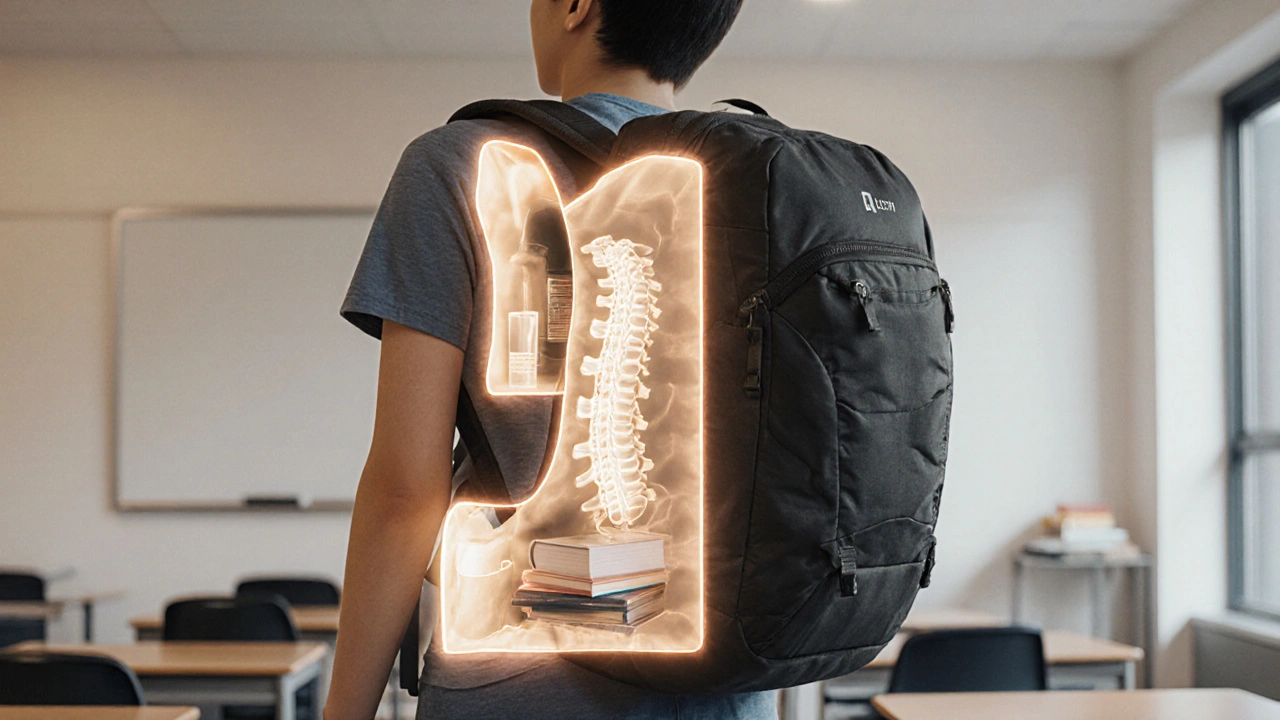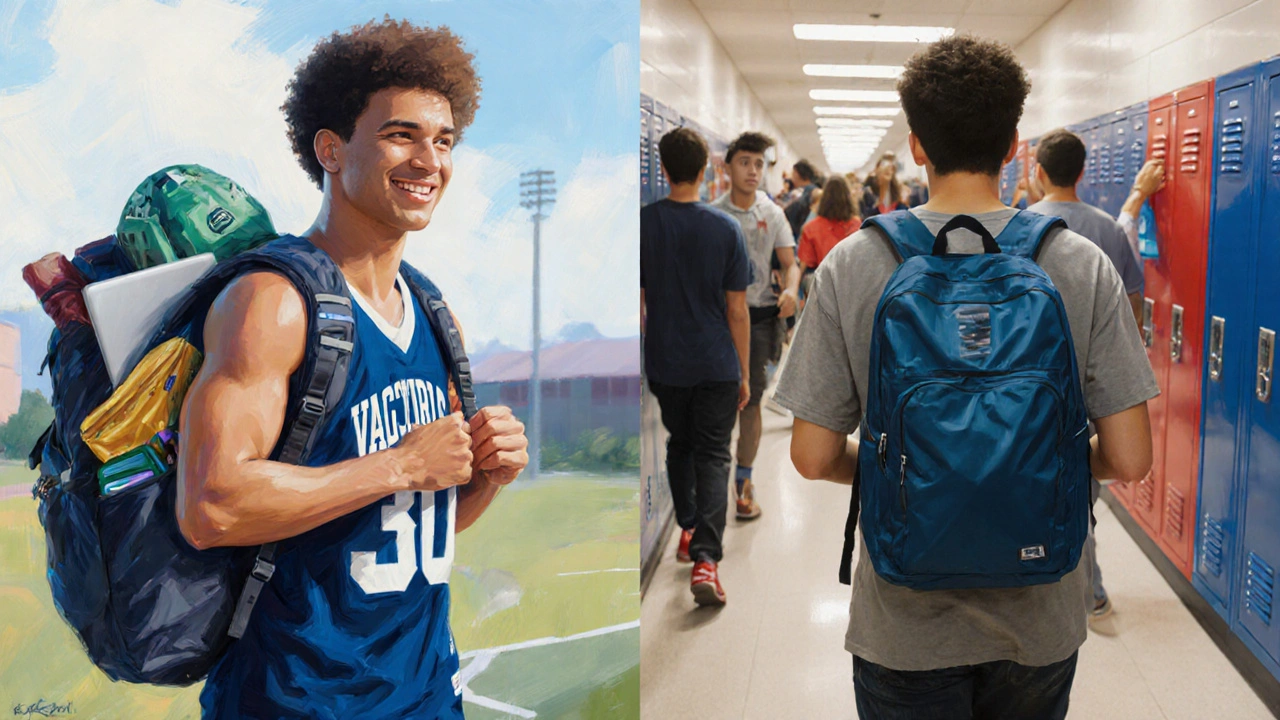Are Bigger Backpacks Better? A High School Student’s Guide to Size, Comfort, and Performance

Backpack Weight & Size Calculator
Check Your Backpack Safety
Determine if your current backpack size and load weight are safe for your body weight according to spine health guidelines.
When you hear the phrase Backpack is a portable bag worn on the back to carry books, laptops, and other school essentials, you probably picture a size that fits your needs. But does a larger bag automatically mean a better one for a high‑school student?
What Does "Bigger" Really Mean?
Backpack size is usually measured in liters, which tells you how much volume the main compartment holds. A 15‑liter pack is considered small, 20‑liter medium, and 30‑liter or more falls into the big‑bag category. Dimensions (height, width, depth) also matter because a tall, narrow bag can feel bigger than a short, wide one even if the volume is the same.
How Size Influences Weight Distribution
Weight distribution is a core part of Ergonomics the study of how equipment fits the human body to minimize strain. A bigger bag usually has a larger frame and more padding, which can help spread weight across the shoulders and hips. However, if you fill a 30‑liter pack with ten textbooks, the extra volume won’t magically make it lighter. The key is the bag’s internal structure - padded backs, internal dividers, and waist straps all help keep the load centered.
Spine Health and Posture for Teens
Teenagers’ spines are still developing, so carrying a heavy load in the wrong way can cause long‑term issues. The Spine health the condition of the vertebral column and its surrounding muscles guidelines from the American Academy of Pediatrics recommend that a backpack’s weight not exceed 10‑15% of the student’s body weight. A larger bag can make it easier to keep weight low in the front and high in the back, but only if the student actually uses the internal compartments correctly.
What High‑Schoolers Actually Need to Carry
Typical daily load includes a few textbooks (1-2 kg each), a laptop (1.5 kg), notebooks, a water bottle, and sometimes sports gear or a lunchbox. Add in a pencil case, headphones, and maybe a small umbrella, and you’re looking at 6-10 kg. The question isn’t just "how much can the bag hold?" - it’s "what do you need to fit comfortably without over‑packing?"

Pros of Bigger Backpacks
- More compartments: Bigger bags often come with dedicated laptop sleeves, shoe pockets, and side water‑bottle holders.
- Better load‑balancing: A larger frame can accommodate a padded back and waist strap, which shifts weight to the hips.
- Future‑proofing: As you move from middle school to high school, you’ll likely need more space for larger textbooks.
Cons of Bigger Backpacks
- Potential for over‑packing: A larger volume tempts students to carry unnecessary items, increasing weight.
- Bulkier profile: Wider bags can be uncomfortable in crowded hallways or on crowded buses.
- Higher cost: Bigger, feature‑rich packs usually carry a steeper price tag.
Backpack Size Comparison
| Size (Liters) | Typical Capacity | Recommended Max Weight | Best For | Drawbacks |
|---|---|---|---|---|
| 15 L | 1‑2 textbooks, tablet | ≤10 % body weight | Light‑load days, freshmen | Limited laptop space, no waist strap |
| 20 L | 2‑3 textbooks, laptop, lunchbox | 10‑12 % body weight | Average days, balanced load | May feel bulky if over‑packed |
| 30 L+ | 4+ textbooks, laptop, sports gear | 12‑15 % body weight | Heavy‑load days, varsity athletes | Easy to over‑fill, higher price |
How to Choose the Right Backpack Size
- Know your daily load. List the items you carry most days and estimate their total weight.
- Measure your torso length (from the base of your neck to the top of your hip). A bag whose back panel matches this length will sit correctly.
- Check for Adjustable straps strap systems that let you fine‑tune the bag’s fit on your shoulders and hips. Padded, wide shoulder straps and a sternum strap are a must.
- Look for a dedicated Laptop compartment a padded sleeve designed to protect a laptop. This often determines the minimum bag size you’ll need.
- Consider durability. Material durability how well a fabric resists wear, tear, and water affects long‑term cost.

Maintenance Tips for Longevity
Even the best‑sized bag can fall apart if you don’t care for it. Spot‑clean fabric with a mild detergent, hang the bag upside‑down to dry, and regularly check stitching around the straps. Replace worn pads and tighten any loose buckles. A well‑maintained bag will keep its shape, keeping weight distribution consistent.
When Bigger Really Is Better
If you’re a varsity athlete who carries a ball bag, a water bottle, plus heavy textbooks, the bigger backpacks option often pays off. The extra compartments keep gear organized, and a sturdy frame helps you meet the 15 % weight guideline while still fitting everything you need.
When Smaller Packs Win
Freshmen who mainly need a laptop and a few notebooks will feel lighter and more agile with a 15‑L or 20‑L pack. Less bulk means easier navigation through crowded lockers and hallways, and the lower price point keeps parents happy.
Bottom Line: Size Must Match Use
There’s no one‑size‑fits‑all answer. The ideal backpack balances volume, weight, ergonomics, and durability for the student’s daily routine. Use the comparison table and the five‑step checklist above to figure out whether a bigger bag truly serves you.
How much weight should a high‑school backpack hold?
The general recommendation is no more than 10‑15% of the student’s body weight. For a 150‑lb teen, that’s roughly 15‑22 lb (7‑10 kg). Exceeding this range can strain the spine and shoulders.
Do larger backpacks have better ergonomics?
Only if they include features like padded backs, adjustable shoulder straps, and waist straps. Size alone doesn’t guarantee comfort; the internal design does.
Should I buy a backpack with a laptop sleeve?
Yes. A dedicated padded sleeve protects the laptop and usually dictates the minimum bag size you’ll need. Look for a sleeve that fits your laptop’s dimensions snugly.
Can a big backpack cause back pain?
It can, especially if it’s overloaded or worn incorrectly. Even a large bag with proper straps can cause pain if the weight exceeds the 15% guideline or if the load isn’t centered.
What material should I look for?
Water‑resistant polyester or nylon with reinforced stitching is a good balance of durability and price. Some premium models use Cordura or ripstop fabrics for extra tear resistance.
Adrienne Temple
October 22, 2025 AT 20:11A bigger pack can be handy, but remember to only fill it with what you actually need 😊.
Sandy Dog
November 11, 2025 AT 22:37When you first saw that massive 30‑liter backpack, it probably felt like the ultimate power move 😎. The extra pockets whisper promises of endless organization, like a secret lair hidden in fabric. You picture yourself marching down the hallway, shoulders balanced, weight distributed like a pro. Yet the reality often sneaks up when you cram textbooks, a water bottle, and maybe a spare pair of shoes into every nook. The padded back panel seems like a cushion, but it can’t mute the strain if the load blows past the 15% rule. Over‑packing becomes a habit; the bag’s size tempts you to add that extra novel, the extra snack, the extra pair of headphones you never use. On the bright side, those same compartments can keep your laptop snug and your gym gear separate, saving you from a chaotic dump after class. The waist strap, when tightened, truly shifts the burden to your hips, turning a mountain into a manageable hill. Still, a bulkier profile can turn tight hallways into obstacle courses, and you might find yourself bumping into lockers more often. The cost factor also sneaks in-bigger bags with all the bells and whistles rarely come cheap, and teen budgets are tight. If you’re a varsity athlete juggling a ball bag and textbooks, the extra volume can be a lifesaver. But for a freshman with just a laptop and a couple of notebooks, that same bag feels like carrying a small suitcase. Remember the spine health guidelines: 10‑15% of your body weight, no matter how fancy the bag appears. A well‑designed frame can help, but it’s not a magic wand that makes weight vanish. So weigh your daily load, test the fit, and ask yourself if you really need every pocket. In the end, the “bigger is better” mantra only holds true when the bag truly matches your routine 😊.
Nick Rios
December 2, 2025 AT 02:02Backpack size really depends on what you carry day‑to‑day. A 20‑liter pack usually hits the sweet spot for most high‑school schedules, offering room for a laptop, a few books, and a water bottle without getting too bulky. Make sure the bag has a padded back and adjustable straps so the weight lands on your hips, not just your shoulders.
Amanda Harkins
December 22, 2025 AT 05:28Sometimes the best choice is the one that quietly fits your routine. You don’t need a fashion statement when a simple, well‑fitted bag will keep your spine happy. Less is often more.